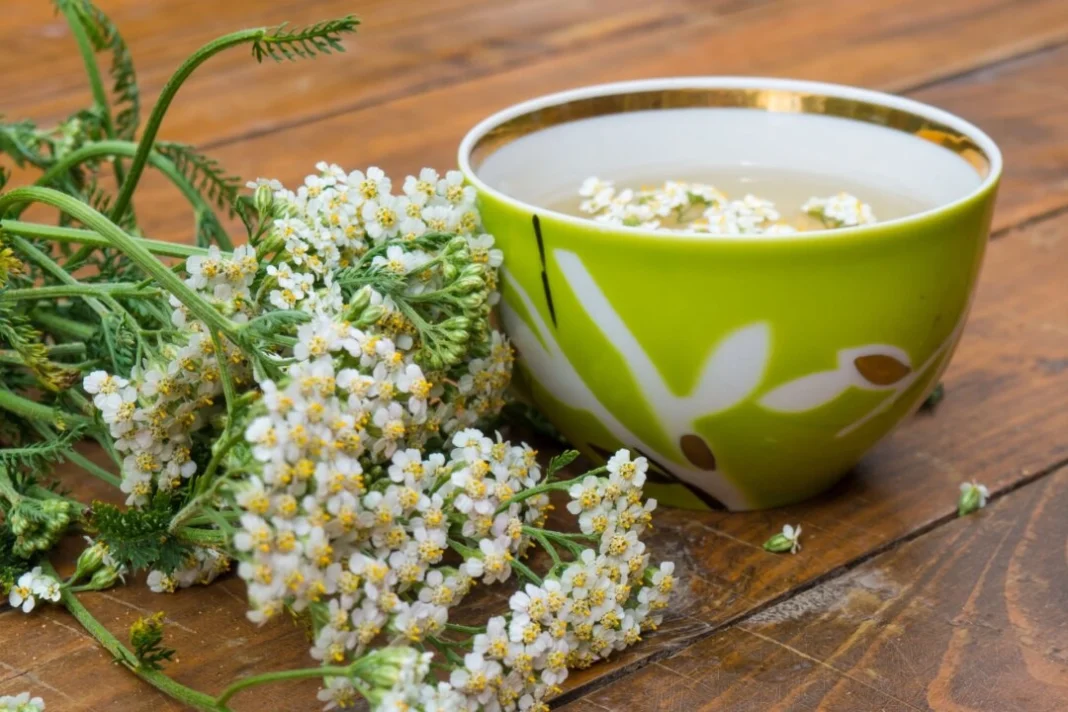|
Getting your Trinity Audio player ready...
|
For those with urinary conditions, a number of medicinal plants that are easy to find and inexpensive can offer relief.
By: Emma Suttie, D.Ac, AP
Researchers from the University of Łódź in Poland reviewed the healing actions of wild and cultivated plants used in Polish folk medicine, specifically to treat urinary diseases. The review studied plants from 53 species belonging to 30 families.
The findings appeared in the journal Pharmaceuticals in March.
Of the numerous plants evaluated by the study, we’ll spotlight four that are easy to find, inexpensive, and effective in providing natural relief for urinary issues.
Yarrow (Achillea millefolium)
A medicinal plant with multiple uses, yarrow is perhaps best known for its ability to treat fevers due to its diaphoretic action—helping the body sweat. Native to Europe and West Asia, it has long stems with an upper crown of small white flowers that are occasionally slightly pink.
Yarrow has astringent, diaphoretic, diuretic, anti-inflammatory, antiseptic, antipyretic (fever-reducing), and anti-hemorrhagic (stops bleeding) properties. It is also a peripheral vasodilator, regulates the menstrual cycle, and is a digestive stimulant.
It is used externally to treat wounds and is a common remedy for colds and urinary disorders. A nosebleed can be stopped quickly by inserting a single leaf into the nostril.
The study states that oral administration of yarrow extract in rats increased diuresis (urine production) noting an extract at a dose of 300 milligrams (mg) per kilogram increased urine production by 30–60 percent four and eight hours after it was given.
A review published in the International Journal of Pharmaceutical Sciences Review and Research details yarrow’s pharmacological actions and wide range of healing benefits. The authors conclude that “The vast survey of literature showed that A.millifolium has an esteemed status in herbs with diverse pharmacological activity spectrum.”
Yarrow can be used as a tincture, ointment, massage oil, or steam inhalation, but is most often taken as a tea. According to the study, teas are often used when treating urinary disorders, but tinctures are also used therapeutically.
Tinctures are preparations that use alcohol (although other things such as vinegar or glycerine can be used) to extract the herb’s active ingredients along with preserving them. Alcohol-based tinctures can last many years and should be stored in a cool, dark place. Tinctures can be made at home or purchased and can be taken directly, mixed with water, or added to hot water or tea.
Yarrow Tea
Pour 1 cup of boiling water over 1–2 teaspoons of the dried herb (all parts of the herb that grow above ground are used medicinally). Leave to infuse for 10–15 minutes. Drink three times daily.
Yarrow Tincture
Take 20–40 drops (1–2 ml) three times daily.
Contraindications: Yarrow is not recommended in pregnancy because of its mild stimulating effect on the uterus.
Celery (Apium graveolens)
Celery is a common vegetable that is easily incorporated into a variety of dishes. The seeds, stalks, and essential oil are also used in many traditional medicines. According to the study, Chinese medicine uses celery to treat high blood pressure and it is used in Arabian medicine for renal pain (the renal system includes the kidneys, ureters, and urethra).
Celery is also a common remedy for arthritis and gout because it clears uric acid from the joints.
According to the study, a dose of 8 grams per kilogram a day increased urinary calcium ion excretions in an experimental model of nephrocalcinosis, a condition in which calcium is deposited in the kidneys. It also significantly reduced serum creatinine and blood urea nitrogen, which are waste products the kidneys remove.
Celery has anti-inflammatory, hypotensive, antispasmodic, sedative, carminative (relieves flatulence), and antirheumatic actions. However, its diuretic and urinary antiseptic properties make it especially helpful in treating urinary system conditions. These actions are primarily because of the volatile oil, apiol.
A 2018 study published in Fitoterapia found that celery extract prevented bladder and kidney infection against E. coli in animal models. The study states that the celery extract “significantly reduced the bacterial load in bladder tissue” of the animals and notes that it had no cytotoxic effect on bladder cells.
Celery can be used medicinally in a variety of ways, depending on the condition. It can be taken as a tea for rheumatic conditions, gout, and urinary disorders, used as a massage oil for rheumatic conditions or on the abdomen for digestive issues, gas and congestion of the liver, as a footbath for rheumatism and gout, or juiced for high blood pressure and nervous exhaustion. The best way to take celery for urinary conditions is as a tea or tincture. Below are instructions for taking each.
Celery Tea
Pour 1 cup of boiling water over 1–2 teaspoons of freshly crushed celery seeds. Let steep for 10–15 minutes. Drink three times daily.
Celery Tincture
Take 2–4 ml of tincture three times daily.
Contraindications: Avoid using celery seeds in pregnancy. Do not take essential oils internally unless under the guidance of a qualified practitioner.
Parsley (Petroselinum crispum)
Parsley is another herb commonly used in everyday dishes and one of the most abundant sources of vitamin C. According to the study, parsley leaves, seeds, and roots have diuretic properties. Diuretics increase the production of urine helping to flush microorganisms out of the bladder and urinary tract.
Like celery, parsley contains the volatile oil apiol, which prevents infection in the urinary system.
According to the study, rats given an extract from parsley seeds had an increase in the volume of their urine and sodium excretion. The effect was comparable to furosemide, a diuretic medication used to treat fluid retention from various conditions.
In another instance reported in the study, aqueous parsley extracts had a beneficial effect on calcium oxalate stones (the most common type of kidney stones) in rats, reducing the amount of calcium oxalate deposits.
In addition to its diuretic actions, parsley is also an emmenagogue, used to stimulate and regulate menstruation, and a carminative, used to ease flatulence.
The leaves, stems, roots, and seeds are used medicinally.
A tea or tincture can be used therapeutically for urinary conditions. Below are instructions for using parsley.
Parsley Tea
Pour one cup of boiling water over 1–2 teaspoons of the dried herb. Let steep for 5–10 minutes in a covered container or teapot. Drink three times daily.
Parsley Tincture
Take 2–4 ml of the tincture three times daily.
Contraindications: Avoid taking parsley in pregnancy due to its stimulating (abortifacient) action.
Dandelion (Taraxacum campylodes)
To many, dandelions are persistent weeds, but to herbalists and holistic health practitioners, they are powerful medicine.
According to the study, dandelion contains a wide range of compounds with healing properties, including phenols and terpenes and vitamins, minerals, proteins, carbohydrates, and fatty acids. It also notes its use as a natural treatment for gout, diarrhea, and problems of the spleen, liver, and bladder.
A comprehensive review of the health benefits of dandelion published in 2021 evaluated 54 studies that described several therapeutic properties attributed to dandelion.
Diuretic
Hepatoprotective
Immunoprotective
Antiviral
Antifungal
Antibacterial
Antiarthritic
Antidiabetic
Antiobesity
Antioxidant
Anticancer
The researchers noted that the most common health benefits reported in the literature were dandelions antioxidant, hepatoprotective (protects the liver), and anticancer properties.
Dandelion is native to North America, Europe, and Asia and is known as a powerful diuretic for treating liver and gallbladder problems. The roots and leaves are used medicinally.
Dandelion can be used in various ways. The young leaves are a common ingredient in salads, sandwiches, and soups. The leaves can be fermented into an herbal beer, the flowers into wine, and the roasted roots are used to make dandelion coffee.
If you want to try dandelion for urinary conditions or any of those listed above, below are instructions for making tea or using a dandelion tincture.
Dandelion Tea
Add 2–3 teaspoons of dandelion root in a cup of water and boil, then simmer for 10–15 minutes. Drink tea three times daily to alleviate urinary conditions, fluid retention, and high blood pressure by stimulating urination.
Dandelion Tincture
Take 40 drops/1 teaspoon/2–5 ml of tincture three times daily. Tincture made of dandelion root and leaves helps dissolve small gallstones, stimulates bile flow, and has a mild laxative effect.
Contraindications: If you have gallstones, use dandelion root only under the supervision of a qualified herbalist or health professional.





